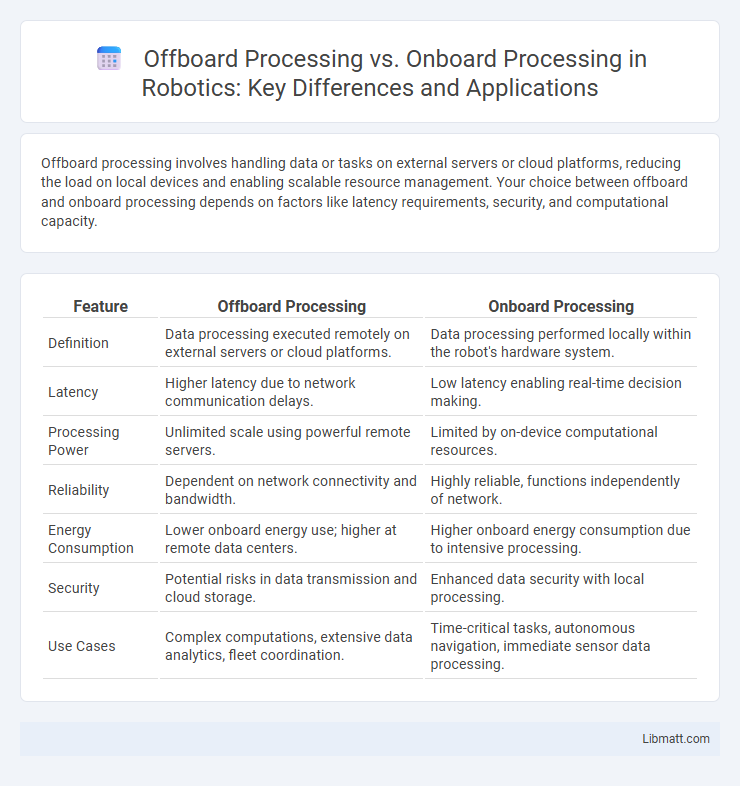Offboard processing involves handling data or tasks on external servers or cloud platforms, reducing the load on local devices and enabling scalable resource management. Your choice between offboard and onboard processing depends on factors like latency requirements, security, and computational capacity.
Table of Comparison
| Feature | Offboard Processing | Onboard Processing |
|---|---|---|
| Definition | Data processing executed remotely on external servers or cloud platforms. | Data processing performed locally within the robot's hardware system. |
| Latency | Higher latency due to network communication delays. | Low latency enabling real-time decision making. |
| Processing Power | Unlimited scale using powerful remote servers. | Limited by on-device computational resources. |
| Reliability | Dependent on network connectivity and bandwidth. | Highly reliable, functions independently of network. |
| Energy Consumption | Lower onboard energy use; higher at remote data centers. | Higher onboard energy consumption due to intensive processing. |
| Security | Potential risks in data transmission and cloud storage. | Enhanced data security with local processing. |
| Use Cases | Complex computations, extensive data analytics, fleet coordination. | Time-critical tasks, autonomous navigation, immediate sensor data processing. |
Introduction to Offboard and Onboard Processing
Offboard processing refers to data analysis performed outside the primary system, often using external servers or cloud-based platforms, enabling enhanced computational power and storage capacity. Onboard processing takes place directly within the device or system, offering real-time data handling and immediate response capabilities crucial for time-sensitive applications. Your choice between offboard and onboard processing depends on factors like latency requirements, data complexity, and available infrastructure.
Definitions: Offboard vs Onboard Processing
Offboard processing refers to data analysis and computation performed externally, typically on remote servers or cloud platforms, while onboard processing occurs directly within the device or hardware generating the data. Offboard systems enable extensive processing power and storage capacity but depend on reliable communication links, whereas onboard processing allows real-time decision-making and reduced latency by handling data internally. Common applications of onboard processing include autonomous vehicles and IoT devices, while offboard processing is prevalent in large-scale data analytics and remote sensing.
Key Differences Between Offboard and Onboard Processing
Offboard processing involves data analysis performed on remote servers or cloud platforms, allowing access to extensive computational resources and storage capacity, while onboard processing executes data directly within the device using embedded processors, enabling real-time decision-making and reduced latency. Key differences include the dependency on network connectivity for offboard processing versus the autonomous operation of onboard systems, and the trade-off between processing power and energy consumption, with onboard processing requiring optimized algorithms for limited hardware. Security considerations also differ, as onboard processing limits data exposure during transmission, whereas offboard processing necessitates robust encryption and data protection measures.
Advantages of Offboard Processing
Offboard processing offers advantages such as enhanced computational power by leveraging cloud-based resources, enabling complex data analysis without burdening onboard systems. It improves scalability and flexibility, allowing updates and maintenance without physical access to devices. Security benefits include centralized control of sensitive data and easier implementation of robust cybersecurity measures.
Benefits of Onboard Processing
Onboard processing offers significant benefits, including reduced latency by processing data directly at the source, which enhances real-time decision-making capabilities in applications like autonomous vehicles and drones. It minimizes bandwidth usage and dependence on cloud connectivity, ensuring reliable performance even in remote or offline environments. Onboard processing also strengthens data security by limiting the transmission of sensitive information, leading to improved privacy and compliance with regulatory standards.
Use Cases for Offboard Processing
Offboard processing excels in scenarios requiring centralized data analysis, secure storage, and complex computational tasks that exceed the capabilities of onboard systems. Industries like autonomous vehicles use offboard processing to enhance real-time decision-making by transmitting sensor data to cloud servers for advanced analytics and machine learning. Your fleet management or IoT applications benefit from offboard processing by enabling scalable processing power and long-term data aggregation beyond the limitations of local hardware.
Applications Suited for Onboard Processing
Onboard processing is ideal for applications requiring real-time data analysis and immediate decision-making, such as autonomous vehicles, drones, and industrial automation systems. It minimizes latency by processing data directly on the device, ensuring rapid response times critical in safety and performance-sensitive environments. Your system benefits from enhanced reliability and reduced dependency on external networks by utilizing onboard processing.
Performance and Scalability Comparison
Onboard processing delivers low-latency responses by handling data directly on the device, ensuring high performance for real-time applications but limited scalability due to hardware constraints. Offboard processing leverages cloud or centralized servers, offering scalable resources and the ability to process large datasets, though it may introduce latency from data transmission. Your choice depends on balancing immediate processing speed with the need for flexible, scalable computational power in your system design.
Security and Data Privacy Considerations
Offboard processing enhances security by centralizing data analysis in secure cloud environments with robust encryption and access controls, minimizing exposure on vulnerable edge devices. Onboard processing improves data privacy by keeping sensitive information locally on the device, reducing the risk of interception during transmission but requiring strong device-level security. Choosing between offboard and onboard processing depends on balancing latency, computational resources, and the specific security and privacy requirements of the application.
Choosing the Right Approach for Your Needs
Offboard processing centralizes data computation in remote servers, ideal for applications requiring heavy processing power and large-scale data storage, such as cloud analytics and complex machine learning tasks. Onboard processing occurs directly on the device, offering real-time data analysis and reduced latency, making it suitable for autonomous vehicles, IoT sensors, and mobile devices with limited connectivity. Selecting the right approach depends on factors like processing speed requirements, connectivity reliability, data security concerns, and energy consumption constraints specific to your operational environment.
Offboard processing vs Onboard processing Infographic

 libmatt.com
libmatt.com